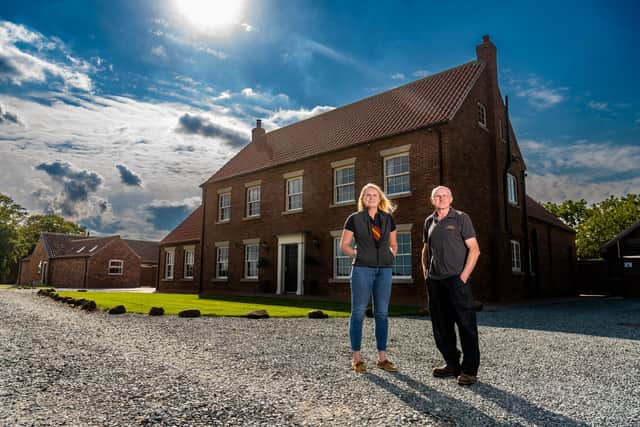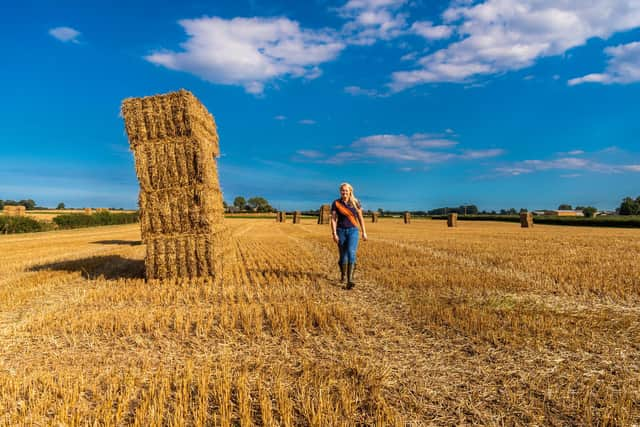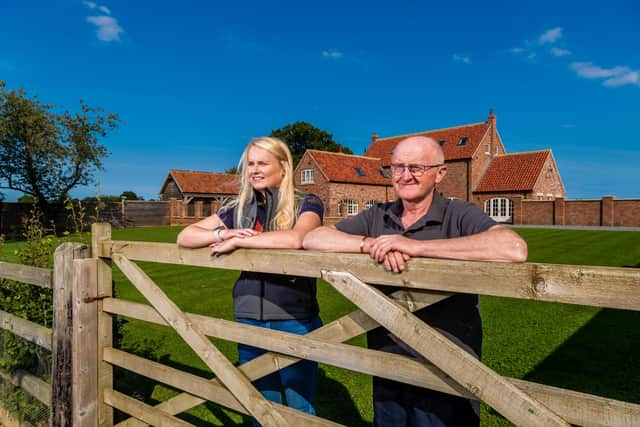Farm of the Week: Father and daughter egg producers who have converted historic family farmhouse into holiday accommodation
In the past two years they have variously faced up to what was, a year ago, a very poor egg price; this year they have suffered from flat crops that threatened their crop yield; but somewhat more positively they have completely rebuilt what was Pasture House farmhouse into what is now fabulous holiday accommodation.
James Dean and his daughter Sarah farm just shy of 300 acres that includes owned land at Grove Farm and rented land at Pasture House. Sarah, who came back home to join her father in their quest to improve overall income, following her graduation at Harper Adams, says this year’s harvest has gone better than initially anticipated.
Advertisement
Hide AdAdvertisement
Hide Ad“We’ve always chosen crops that are good standers and we’ve chosen well but this year has been a really big test as we’ve had a lot of flat crops. We’ve found it difficult to combine so we’re currently focussing on choosing our wheat varieties for next year, a decision which we will have to make imminently.


“This year our predominant winter wheat variety was Parkin, which we’ve had for a few years, but we will be looking to swap it this time.
Sarah says it’s not all been bad news on the variety but given what has happened there is a need to change.
“Our wheat has done pretty well, averaging 11 tonnes to the hectare, that’s over 4 tonnes per acre, and we are really happy with that especially because of it being so wet just before harvest. We thought some of the bushel weight would disappear because it had been sat in a field for so long. You could just tell that it was all going a bit brown and was not very attractive but fortunately it held on to its yield.
Advertisement
Hide AdAdvertisement
Hide Ad“Last year we didn’t need to use our grain drying facilities at all. This year with the crops all being wet we’ve used them on everything. We’ve now finished all of our own harvest at home and dad is just finishing by combining 27 acres of peas for a neighbour.


This year’s arable cropping across Grove Farm and Pasture House has seen just short of 150 acres of winter wheat, with the rest of the cropping down to winter barley variety Memento, which yielded around 10 tonnes per hectare; oilseed rape that yielded 3.7 tonnes per hectare; and winter beans that yielded 5 tonnes.
“We’ve not made anywhere near the yield we made on oilseed rape last year and yet we’ve not done anything much different,” says Sarah who explains their predominant land type and how she and her father work together at harvest.
“We are on mainly medium loam. It’s not Wolds land, and not Holderness clay. We’re kind of in the middle. We are mainly on with min-till using a Horsch Terrano working the land from stubble. We do have a plough, which we use for the beans. We’ve been min-till for the past five years.
Advertisement
Hide AdAdvertisement
Hide Ad“Dad drives the combine and I lead the corn. Our wheat and barley all goes into mill and mix of our own chicken feed and as long as our rotation works efficiently we don’t usually need to buy or sell any.


“We grow a small amount of oilseed rape as a break and that’s the only thing that leaves the farm. Winter beans are another break and we’ve started adding that into poultry ration because soya meal, which is a main part of protein for the chicken’s ration is very expensive and although beans are nowhere near the protein content of soya it’s just an alternative we’ve started adding.
The arable farm is effectively feeding the free-range poultry operation that is producing the eggs that creates the farm income. Sarah says this year’s egg price is a great deal better than it was in 2022.
“We had a really rough time last year. The egg price was appalling and we weren’t making anything at all. Supermarkets, through media pressure and industry pressure have started listening and the egg price has gone up, which it needed to as costs of soya, fuel and electric have all increased.
Advertisement
Hide AdAdvertisement
Hide Ad“We have 26,000 birds across three sheds, which is not big these days but it works for us. The birds come in at 16 weeks and start laying within a few weeks. We tend to keep them a year, with them leaving at 72 weeks, but at the moment they are 73-74 weeks and we don’t plan on them going until later this autumn as we are trying to get drilling over first.
“Egg production has been really good this year. We were a little worried that the birds would become over-exerted but we’ve had a lower average egg weight, which helps make them last longer. They are all Hi-Line birds. The eggs go to Eggsell at Elliott’s in Bewholme, which is nearby. We have around 12 hectares of grassland too, which is for the birds.
“Dad lives and breathes farming. He also combines crops for another farming family in Rise, the Bucktons, who are close friends of ours and handle our spraying, and the peas that dad is combining for a neighbour we will put in our poultry ration this year as an additional protein source.
The big project that both James and Sarah have been involved with in recent years has been the total rebuild of Pasture House and the renovation of the stables block into holiday accommodation that took its first guests in October 2021.
Advertisement
Hide AdAdvertisement
Hide AdSarah says it is all part of the family’s past – and now its future.
“My great grandma, Ena Croft, was born inside Pasture House and we bought the house back in the mid-noughties. We didn’t start doing anything with it until starting our project in 2017. The original farmhouse was derelict. We didn’t know whether to take it down, but eventually decided to go for a complete new build and renovate the stable block.
“We started work on everything in 2019 after receiving planning approval. Pasture House sleeps 12 and the stable block sleeps 4. Many parties are booking both. We’ve just had our second full summer and it’s going really well. One of the things I am finding is that people are starting to book just a few weeks in advance rather than months, but that’s probably because people are getting to know us. We’ve had one group booking that has stayed three times since April 2022.
The Deans also have two small wind turbines and ground source heat pumps that supply the farmhouse and holiday cottages. James and Sarah have both been involved with Brandesburton YFC. Last year Sarah was Northern Area Secretary.
Advertisement
Hide AdAdvertisement
Hide AdJames’ full name usually crops up in conversations. Sarah says that there was a time when his old school bus driver asked his name and when James said his name was James Dean, he thought he was making it up.
www.pasturehouseholidaycottages.co.uk